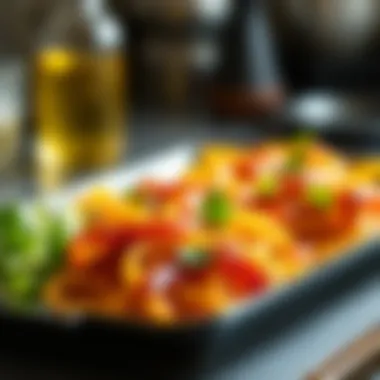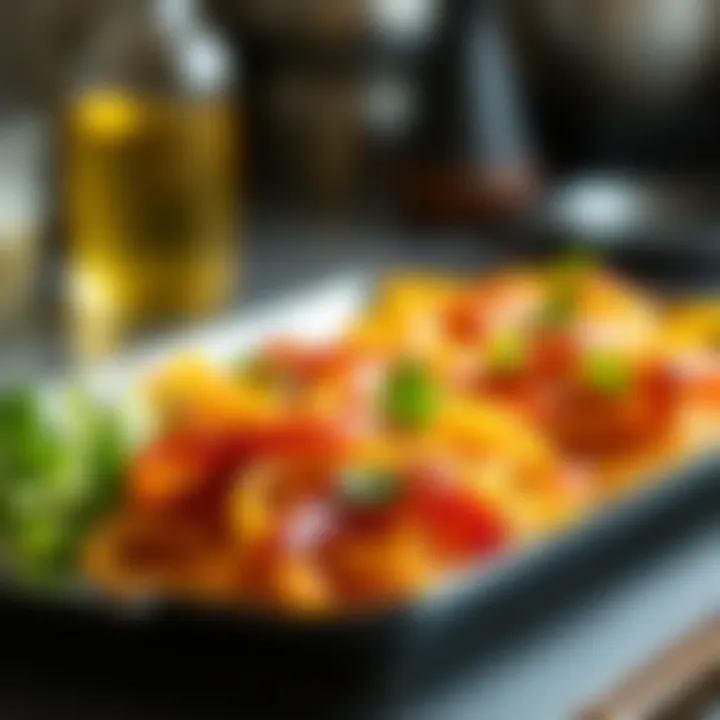Mastering Frying Techniques: Oils, Tips, and Health


Intro
Frying with oil is an age-old method that has stood the test of time in diverse culinary cultures. This technique not only imparts unique flavors and textures to food but also enhances the overall eating experience. The sizzling sound, the aromatic smell, and the pleasing crunch create a multi-sensory delight that is hard to resist. However, frying is more than just a technique; it involves understanding various oils, the chemistry at play, and the nuances of cooking temperatures. From crispy fried chicken to golden french fries, the dishes that emerge from the frying pan are often the highlight of any meal.
As we dive into the subject of frying with oil, it is crucial to examine the nitty-gritty details that make the process not just effective but also safe and nutritious. Let us first explore the ingredients essential to frying, as well as tools and techniques that can turn any home cook into a frying maestro.
Prelude to Frying with Oil
Frying with oil is much more than just a method of cooking; it’s a way of bringing flavor and texture to our meals that few other techniques can replicate. The practice of frying spans cultures, continents, and centuries, and its enduring popularity is testament to its satisfaction and versatility. Whether you are a novice in the kitchen or a seasoned chef, understanding frying is pivotal for mastering culinary arts.
At its essence, frying involves submerging food in hot oil, which not only cooks the food but also creates a delightful crust. This browning effect enhances flavor through several chemical reactions. Additionally, frying provides textures that can range from crispy to tender, appealing to various palates. With the right techniques and knowledge, one can elevate ordinary ingredients into dishes that are truly memorable.
However, frying is not without its challenges, and being aware of such nuances is crucial. Factors like oil type, temperature, and ingredient preparation can make or break a dish. One might think frying is simple—just heat oil and toss in some food—but there's a whole science behind it.
As we explore the subsequent sections of this article, we will peel back layers of knowledge on frying techniques, oil selection, and even safety measures. Later, we’ll discuss historical contexts and health implications, as understanding where we came from can guide us in what we choose to fry today.
Frying well means not just following a recipe but appreciating the dance of flavors and the artistry involved in creating something delicious.
Frying is integral to many culinary traditions, and learning the ropes can unlock a world of preparation techniques. We'll dive deeper into the art of frying, not only equipping you with the necessary skills but also igniting an appreciation for this timeless technique. Through this comprehensive guide, you can expect to become more adept and confident in your frying endeavors, ensuring that your dishes shine on the table.
The Science Behind Frying
Frying isn't just about cooking; it's a ballet of chemistry and physics in the kitchen. Understanding the science behind frying allows a cook to not only appreciate the technique but also to elevate their culinary creations. By grasping diverse elements like heat transfer and the Maillard reaction, one can grasp how to tweak dishes to perfection, adjust flavor profiles, and even stimulate certain textures. It's a realm where science meets art, all underpinned by practical insights into cooking dynamics.
Heat Transfer Mechanism
In frying, the primary mechanism at work is heat transfer, which is crucial for achieving the right texture and flavor in food. The process begins when the oil, heated to its smoke point, comes into contact with the food. Heat transfers from the oil to the food by conduction. This immediate contact is vital because it causes the water within the food to evaporate quickly, which in turn helps form a crispy crust on the outside.
The type of fryer also affects the efficiency of this process. For instance, deep frying immerses food entirely in hot oil, providing even and consistent heating. In contrast, with shallow frying, only part of the food is in the oil, necessitating a careful flip to achieve a uniformly cooked item.
The temperature of the oil is critical here. Oil that’s too cool will soak into the food, yielding a greasy result rather than a crisp one. Conversely, oil that's too hot can burn the outer layer before heat penetrates to the center. A good rule of thumb is to check the oil temperature before adding food; a drop of water sizzling in the oil is oftentimes a decent indicator it’s ready.
Maillard Reaction and Its Impact
The Maillard reaction is the unsung hero of flavor when it comes to frying. Named after French chemist Louis-Camille Maillard, this chemical reaction occurs when amino acids and reducing sugars react under heat, creating a range of delicious flavors and a characteristic browning on the food's surface.
This process not only enhances the color but also dramatically alters the taste. For instance, when you fry a piece of chicken, the beautifully browned exterior offers a contrasting crunch against the tender inside—a direct result of the Maillard reaction in action.
While frying, various factors can influence the extent of the Maillard reaction. Here are a few key points to consider:
- Temperature: Higher temperatures promote a faster reaction, but too much heat can lead to burning.
- pH Levels: A more alkaline pH can enhance the Maillard reaction. This is part of why certain marinades (like those including baking soda) can boost the browning effect.
- Time: The longer food spends in the hot oil, the more pronounced the reaction. However, timing is essential; it's important to avoid overcooking and to strike the right balance.
The Maillard reaction is why that crispy fried chicken not only looks delicious but also has the flavor to match.
Understanding the mechanisms at play in frying helps one refine their approach, ensuring dishes are not just cooked, but masterfully crafted. Next, let’s dive deeper into various frying techniques, keeping these scientific principles in mind.
Types of Frying Techniques
Frying is an essential culinary method, and understanding various techniques can significantly impact the flavor, texture, and overall quality of the dishes you prepare. Mastering different frying techniques not only enhances your cooking repertoire but also opens the door to a multitude of styles and flavors from around the world. Each technique has its own unique advantages and nuances, making it essential for chefs and home cooks alike to familiarize themselves with each style.
With the right technique, you can create everything from crispy fried chicken to tender stir-fried vegetables. It’s about getting the right oil temperature, knowing your food's composition, and timing everything just right. By the end of this section, you should feel ready to tackle any frying method with confidence.
Shallow Frying
Shallow frying, also known as pan-frying, involves cooking food in a small amount of hot oil, usually just enough to cover the bottom of the pan. This technique is fantastic for achieving a crispy texture on meats and vegetables while maintaining moisture inside.
One of the key benefits of shallow frying is its efficiency. The method allows for faster cooking times compared to deep frying because the food has more direct contact with the hot surface of the pan. Shallow frying also requires less oil, making it a healthier alternative while still producing deliciously crispy results.
Take, for instance, a classic approach to frying potatoes. Slice them into thin rounds, season generously, and then fry them in just enough oil to reach that lovely golden-brown hue. Not only does this technique enhance flavor, but it also provides perfect crispiness without overpowering the dish with oiliness.
Deep Frying
Deep frying is a method wherein food is submerged in hot oil, generally reaching temperatures between 350°F to 375°F. This technique is notoriously known for delivering an indulgent crunch and rich flavor. The heat rapidly cooks the exterior, creating a crispy crust while sealing in moisture and flavor within the food.
While deep frying can be a bit daunting due to the necessary temperature control and potential safety concerns, mastering it can elevate your cooking significantly. Think of the delicious crunch of a perfectly fried doughnut or the irresistible texture of a tempura vegetable. With deep frying, however, it’s critical to be cautious. Underestimating oil temperature can lead to greasy food, while overheating can result in burnt exteriors.
When considering various options for deep frying, foods from fried chicken to tempura can be made with finesse if you stick to the correct oil type and temperature. Don't forget to allow your fried goodies to drain on paper towels after frying to remove excess oil.
Pan Frying
Pan frying refers to cooking food in a moderate amount of fat in a frying pan. Unlike shallow frying, which uses just enough oil to cover the base, this technique usually involves using a bit more oil while keeping the heat at a mid-range level. This technique ensures even cooking and helps foods develop a lovely golden crust.


This method is especially suited for delicate proteins or items that benefit from gradual cooking, such as fish or eggs. The key is to avoid moving the food around too frequently. Let it develop a nice sear before flipping. For instance, a nicely pan-fried salmon fillet can offer rich flavors and a delightful texture—sit tight, get that color on one side before flipping!
Stir Frying
Originating from Asian cuisines, stir frying is a high-temperature cooking method that quickly cooks food in a small amount of oil while continuously stirring. The essence of stir frying is speed and precision; ingredients are typically cut into bite-sized pieces to ensure even cooking and to minimize the time they spend in the hot oil.
This technique is incredibly versatile, allowing not only for various ingredients, like meats and vegetables, but also for an array of flavors to be integrated through sauces and spices. As the food cooks fast, retaining its color, texture, and nutrients, creating a vibrant stir-fry can be a feast for the eyes as well as the palate. A classic example of this is the colorful medley of chicken, bell peppers, and broccoli, which can be ready in just a matter of minutes.
In summary, understanding these frying techniques will give you the tools to unleash your culinary creativity and enhance the dining experience for yourself and others.
Selecting the Right Oil for Frying
Selecting the right oil for frying is a cornerstone of successful cooking. Oil influences not only the flavor of the dish but also its texture and health aspects. Therefore, understanding the characteristics and benefits of different oils becomes essential to achieving culinary excellence. The choice of oil can make or break a dish. Factors such as taste profile, heat tolerance, and nutritional content should all be on the radar when picking an oil for frying. It is not merely about cooking; it is about enhancing the overall experience of the meal.
Common Oils Used in Frying
Vegetable Oil
Vegetable oil is a common choice among cooks, and it earns its place for several reasons. This oil, often a blend of various plant oils, has a high smoke point, usually around 400°F (204°C). This characteristic means it can be heated for frying without burning easily, which is crucial for achieving that crispy texture many seek in fried foods.
One key characteristic of vegetable oil is its neutral flavor. This allows the natural flavors of the food to shine through, making it a versatile option in different cuisines. It's often less expensive than specialized oils, making it popular for both home cooks and professional kitchens. However, a downside can be its processing, which sometimes involves chemical extraction methods that might not appeal to health-conscious individuals.
Canola Oil
Canola oil has gained impressive popularity, especially for its health-friendly profile. Extracted from the seeds of the canola plant, it is low in saturated fat and contains omega-3 fatty acids, which are beneficial for heart health. Its smoke point is about 400°F (204°C), similar to vegetable oil, making it a solid candidate for frying.
What sets canola oil apart is its mild taste, allowing it to complement various dishes well. It's an excellent choice for those who are conscious of their fat intake. On the flip side, the manufacturing process can sometimes involve refining with chemicals, which might limit its appeal for those preferring organic options.
Olive Oil
When you think of culinary finesse, olive oil often comes to mind, especially for Mediterranean dishes. Its rich flavor profile can elevate a dish, providing a delicious base for frying. However, the smoke point of extra virgin olive oil hovers around 350°F (175°C), which can be lower than other oils.
Olive oil's key characteristic lies in its antioxidants and healthy fats. It’s celebrated for its heart health benefits and its role in reducing inflammation. While its flavor is a big draw, this oil is not always the best for high-temperature frying due to its lower smoke point. If you're aiming for pan frying or sautéing, it certainly excels. A potential downside is its higher price point compared to other cooking oils, which can make it less accessible for everyday frying by budget-conscious cooks.
Peanut Oil
Peanut oil is a favorite in Asian cuisine, particularly in dishes that require high-heat cooking. Known for its high smoke point of about 450°F (232°C), it's excellent for deep frying and helps produce that perfect golden crust on foods.
The distinct flavor of peanut oil is nutty yet subtle, which pairs well with many dishes. It's highly regarded for its ability to withstand high temperatures while infusing a slight flavor. However, for those with peanut allergies, it can pose a significant risk. Additionally, if you are not a fan of the nuttiness, it might not be your first choice.
Smoke Point Considerations
The smoke point of an oil is the temperature at which it begins to smoke and break down. When frying, using an oil that can withstand high temperatures is crucial as it affects the stability and flavor of the food. Oils with higher smoke points tend to break down less and impart greater flavor to fried foods, making them the top picks for frying techniques.
Understanding these factors allows you to choose the right oil tailored to your preferences and cooking needs, making the frying process both successful and enjoyable.
Preparing Ingredients for Frying
When it comes to frying, the preparation of ingredients makes a significant difference in the outcome of your dish. Whether you're dealing with vegetables, meat, or seafood, properly preparing your ingredients can lead to even cooking, enhanced flavor, and overall culinary success. This section will delve into why ingredient preparation is essential, focusing on two crucial aspects: cutting techniques and marination.
Cutting Techniques for Even Cooking
Cutting your ingredients uniformly is vital for achieving consistent cooking results. When pieces are of uneven sizes, some may become perfectly crispy, while others end up undercooked or overdone. Therefore, understanding various cutting techniques can elevate your frying game.
- Julienne: This technique involves cutting ingredients into thin strips, making them ideal for quick frying. Think about how stir-fried vegetables need to cook rapidly in high heat – uniform pieces help ensure they all reach the perfect texture at the same time.
- Chopping: Simple chopping can work well for thicker cuts, like potatoes. Uniform cubes allow for homogenous cooking, which is especially important for denser ingredients that need more time in the oil.
- Slicing: For proteins such as chicken or beef, slicing against the grain can make a significant difference in tenderness. This avoids tough bites, leading to a more enjoyable texture once fried.
Using sharp knives and maintaining a stable cutting surface must not be overlooked. A dull knife not only makes the task tedious but can also lead to accidents. It’s like trying to slice butter with a cold knife – frustrating and ineffective.
Marinating Ingredients
Marination adds layers of flavor that can transform your fried dish. The benefits of marinating range from enhancing taste profiles to tenderizing tougher cuts of meat. When ingredients soak up the marinade, they undergo a change that can elevate your dish from bland to grand.
- Flavor Infusion: A well-crafted marinade, whether it’s tangy, spicy or sweet, penetrates the food as it sits. For instance, letting chicken drumsticks marinate in a blend of soy sauce, garlic, and ginger for a few hours ensures that every bite is packed with flavor.
- Tenderization: Acidic components, such as lemon juice or yogurt, can break down proteins, making meats more tender. This technique is particularly effective for cheaper cuts of meat that often become tough when cooked.
- Oil's Role: Oil in marinades can contribute to crispiness during frying. While it seems counterintuitive, a little oil in your marinade can help the surface of the food to fry more efficiently, resulting in a delicious crunch.
The time needed for marinating can vary; anything from a quick 30 minutes to overnight in the fridge can create different outcomes. It's crucial to avoid over-marinating, especially with acidic solutions, as this can lead to mushy textures.
"Preparation is the cornerstone of success in frying. Treat your ingredients with care and the results will speak for themselves."
Temperature Control in Frying
When frying, the temperature can be the difference between perfectly cooked food and a kitchen disaster. Proper temperature control is not simply a matter of preference; it significantly affects the texture, flavor, and safety of the food being prepared.


Importance of Oil Temperature
Maintaining the right oil temperature is crucial – it impacts how the food cooks, the absorption of oil, and even how crispy the final dish will be. The magic number often cited for frying is around 350 to 375 degrees Fahrenheit, but how do we get there?
- Crispiness: Cooking at a higher temperature generally yields a crispier surface, which many home cooks and professional chefs strive for. If the oil is too cold, the food will absorb more oil, making it greasy instead of crispy. A good rule of thumb is to heat the oil until it shimmers or a drop of water flicked into the pan sizzles immediately.
- Safety: Exceeding the smoke point of your oil can lead to burning, and in some cases, hazardous fumes. It's not just about the quality of your food; it's also about kitchen safety. Oils vary widely in smoke points; for example, olive oil has a lower smoke point compared to oils like avocados.
- Even Cooking: Cooking food at the right temperature ensures it cooks evenly, preventing a situation where the outside is done but the inside remains raw. For example, frying chicken at a too-low temperature results in a brown exterior but often leads to undercooked meat inside.
- Flavor Development: As the food interacts with hot oil, browning occurs, which enhances flavor. This reaction relies on maintaining a consistent oil temperature.
Ultimately, thermometers are your best friends in frying. A digital kitchen thermometer can help you track oil temperature accurately. Investing in a good thermometer might seem trivial, but trust me, when it comes down to achieving that crispy, golden brown exterior, it makes all the difference.
Key Takeaway
"Temperature control in frying is about balancing safety, flavor, and texture. An adept cook is one who understands this delicate dance."
Common Frying Errors and Solutions
When it comes to frying, even seasoned chefs can trip up on a few common mistakes. Understanding the most frequent errors and how to avoid them is essential for achieving crispy, golden perfection. Addressing these problems can significantly enhance the flavor and presentation of your dishes. Not only do the right techniques make for better-tasting food, but they also contribute to safer cooking practices.
Overcrowding the Pan
One of the cardinal sins of frying is overcrowding the pan. When you cram too much food into the hot oil, the temperature of the oil drops considerably. This has several undesirable effects: the food ends up absorbing more oil, leading to greasy results, and it cooks unevenly, risking a burn on the outside while still raw on the inside.
To avoid this, you should fry in batches, ensuring that the oil can maintain its temperature. A good rule of thumb is to leave a little space between pieces, allowing hot air to circulate. Depending on the ingredient, whether you are frying chicken or vegetables, typically about four to six pieces per batch will yield optimal results.
"Cooking is like love. It should be entered into with abandon or not at all." - Harriet van Horne
Some tips to remember include:
- Choose the Right Size Pan: A larger skillet or pot can handle more food while keeping the oil temperature stable.
- Test Before You Drop: When placing food in the oil, drop a small piece first to see if the oil sizzles. If it doesn’t, wait for the oil to heat up.
- Maintain Constant Temperature: Use a kitchen thermometer to ensure the oil stays at the desired frying temperature.
Incorrect Oil Temperature
The temperature of the oil is a make-or-break factor when frying. Too low, and the food becomes oily and soggy; too high, and it can scorch and taste burnt. The ideal frying temperature often lies between 350 to 375 degrees Fahrenheit, depending on the specific food being cooked. Each type of food has its own recommended frying temperature, so it’s essential to familiarize yourself with these guidelines to achieve the best results.
To avoid the pitfalls of incorrect oil temperatures, it’s beneficial to invest in a thermometer designed specifically for frying. This will help you track the heat level accurately. If you're frying without a thermometer, look for visual cues: a gentle simmer and small bubbles indicate that the oil is ready for frying. Conversely, a rapid, excessive bubbling could signify the oil is too hot.
Make sure to consider:
- Pre-setting the Heat: Preheat the oil before adding any food for even cooking.
- Monitor the Heat During Cooking: If you notice the oil cooling down as you add ingredients, then increase the heat slightly to maintain the correct temperature.
- Adjusting Between Batches: After frying several items, the oil temperature can drop, necessitating more heat for subsequent batches.
Getting frying right requires diligence but yielding correctly cooked delicacies is worth every bit of effort. By steering clear of these common errors, you'll find that frying can be a highly satisfying and rewarding cooking method.
Safety Measures in Frying
When it comes to frying, ensuring a safe cooking environment is paramount. Frying with oil, while delicious, poses potential hazards if not approached with care. Adopting safety measures not only protects you during the cooking process but also enhances the overall experience of creating your favorite fried dishes. By following specific guidelines, you can minimize risks associated with oil, promoting an enjoyable cooking atmosphere.
One of the main dangers is the possibility of oil igniting or splattering. Hot oil can cause severe burns, and a grease fire can escalate quickly, making it vital to prepare adequately. Moreover, using the right techniques helps maintain a clean kitchen, reducing the likelihood of accidents.
Benefits of Safety Measures
- Burn Prevention: Keeping a safe distance and using proper utensils helps avoid contact with scorching oil.
- Fire Safety: Monitoring oil temperature and avoiding overheated oil significantly reduces fire risk.
- Kitchen Cleanliness: Preventing splatters keeps your kitchen tidy, which aids in maintaining a safe cooking space and overall hygiene.
Considerations in Frying Safety
When frying, there are several factors to keep in mind:
- Use the Right Equipment: Always utilize sturdy pans that can withstand high heat. Non-stick skillets are tempting, but selecting a deep pot for frying is often beneficial, helping contain oil and splatter.
- Temperature Control: Use a thermometer to keep track of the oil's temperature. Oils can reach flammable temperatures, making it crucial to maintain the right heat. It is ideal to keep the oil between 350°F to 375°F (175°C to 190°C) for effective frying.
- Avoid Overcrowding: Adding too many ingredients at once can reduce the oil's temperature, leading to soggy food and an increased chance for splatter. Hence, fry in batches when necessary.
- Stay Alert: Never leave frying unattended. Being present ensures prompt action in case something goes awry. Always have a pot lid nearby to smother a flame if necessary.
- Use Proper Utensils: Long-handled tools can offer greater safety when trying to manipulate food items in hot oil.
"Taking precautions in the kitchen can save more than a burnt dinner; it can save lives."
By sticking to these safety measures, you can almost guarantee a safer frying experience. Remember, cooking should be a pleasure, not a perilous task.
Health Implications of Frying
Frying is often viewed through the lens of culinary delight, but it's equally crucial to consider its health implications. When you delve into the world of frying, you're not just enjoying a crispy exterior or enhanced flavor; you're engaging with the scientific factors that make those crunchy bites possible. In this section, we will explore the elements that contribute to the health aspects of frying, emphasizing the importance of informed choices regarding what, how, and how much we fry.
Understanding Trans Fats
Trans fats are the bad guys in the oil world, often lurking in fried foods, baked goods, and some processed items. They are created through a process called hydrogenation, which solidifies liquid oils, making them more shelf-stable and cheaper for manufacturers. However, they come with a hefty cost to our health.
Trans fats are known to raise bad cholesterol (LDL) levels while lowering good cholesterol (HDL) levels in our bodies. This double whammy can increase the risk of heart disease, stroke, and type 2 diabetes.
Big culprits in the frying landscape—like fast-food fries, donuts, and pastries—can often pack a surprising amount of trans fats. Thankfully, the food industry is becoming more aware of these risks, leading to a gradual reduction in the use of trans fats in commercial cooking. However, being cautious and reading labels will always be your best bet:
- Look for “0 grams trans fat” on labels.
- Keep an eye out for partially hydrogenated oils in the ingredient lists.
- Opt for fresher options from local kitchens; they usually use healthier fats.


Be aware: Not all fried foods are created equal, and many culinary traditions find healthier alternatives to frying that preserve flavors without the health risks associated with trans fats.
Moderation and Balance in Diet
The cooking method is one thing, but how much we consume is arguably just as significant. Moderation is key when indulging in fried foods. Frying can still be part of a healthy diet, but balance is essential. This means accompanying fried items with a variety of foods rich in nutrients to create a well-rounded meal. Here are some points to keep in mind when considering the health implications of frying:
- Pair fried foods with vegetables. Add sautéed greens or a fresh salad to your plate to lift the overall nutritional value of the meal.
- Don't make frying your primary cooking method. Strive to include other cooking techniques like steaming, grilling, or baking to diversify the palate and nutrient intake.
- Understand portion sizes. Instead of a heaping plate of fries, consider sharing a smaller order or substituting with baked alternatives.
In summary, enjoying frying is all about balancing those pleasures with health-conscious decisions. Fry in moderation, choose your oils wisely, and always aim for a colorful plate. By doing so, you can savor the delicious world of frying while keeping an eye on your health. Remember, the goal is indulgence without the remorse.
Innovative Alternatives to Traditional Frying
In the culinary world, innovation is key to adapting to changing tastes, preferences, and health considerations. This section explores some of the most promising alternatives to traditional frying, emphasizing their importance in contemporary cooking. As the home cook realm shifts toward healthier habits or seeks convenience, these methods arise as viable solutions. They not only cater to health-conscious consumers but also offer a plethora of unique flavors and textures that traditional frying might struggle to achieve.
Air Frying
Air frying has surged in popularity over recent years, touted as a healthier counterpart to conventional frying. Utilizing rapid air circulation, an air fryer cooks food by enveloping it in a whirlwind of hot air, creating a crispy surface without the need for a heavy oil bath. The beauty of air frying lies in its versatility; you can whip up everything from crispy French fries to succulent chicken wings with significantly less fat than traditional methods.
Benefits of Air Frying:
- Reduced Fat Intake: Because air fryers require minimal oil, dishes retain flavor while slashing fat content.
- Quick Cooking Times: Air fryers often cook meals faster than standard ovens, making them perfect for weeknight dinners.
- Easy Cleanup: Many air fryer components are dishwasher safe, making cleanup a breeze, which is a major win for busy cooks.
- Versatile Cooking Options: They can roast, bake, and even grill, providing a one-stop appliance for various culinary needs.
One thing to keep in mind, however, is that while air frying can deliver similar crispiness to frying with oil, the flavor can differ. The texture might be slightly less indulgent, so prior experience with the food may influence your satisfaction with the outcome.
Oven Frying Techniques
Oven frying, another worthy alternative, employs the dry heat of an oven to achieve similar results to frying, but once again without the extensive use of oil. This method involves coating food in a light dusting of flour or breadcrumbs and cooking it at high temperatures, creating a golden crust much like its deep-fried counterpart.
Key Aspects of Oven Frying:
- Lower Oil Use: Just like air frying, oven frying requires little to no oil, making it a healthier cooking method.
- Even Cooking: The circulation of hot air in the oven ensures even cooking, which can sometimes be challenging in pan frying.
- Flavor Enhancement: Baking at high temperatures can caramelize ingredients, producing a delicious depth of flavor.
- Batch Cooking: Great for cooking larger portions simultaneously, especially when preparing family meals or entertaining guests.
Though oven frying does take longer than air frying, the results can be worth the patience. It’s essential to experiment with different seasonings and coatings to find the perfect balance of flavor and crispiness.
Ultimately, comparing air frying and oven frying is more about the preference of the cook and the desired outcome. Some might find the texture of air-fried foods superior, while others may prefer the richer flavor often achieved through traditional oven techniques.
"Innovative cooking methods offer not just convenience but allow home cooks to remain faithful to their health goals."
By embracing these alternative frying methods, the modern cook can indulge in the pleasures of fried foods without sacrificing their well-being. Each technique offers its benefits, and exploring them can lead to delightful culinary discoveries.
Culinary Inspirations with Fried Dishes
Frying, as a cooking method, has carved out its space among culinary techniques, serving a pivotal role in diverse global cuisines. When delving into the world of frying, one cannot help but appreciate the rich tapestry of flavors and textures it offers. Frying is not merely about cooking food; it’s about transforming the ordinary into something delightfully extraordinary. The sizzling sound of food plunging into hot oil often heralds a festival of flavors, and countless culinary traditions showcase how this technique can elevate even the simplest ingredients.
Importance of the Topic
Understanding culinary inspirations stemming from fried dishes sheds light on the artistry behind this method. Each cuisine employs frying in unique ways, achieving signature dishes that resonate with cultural identity.
- Flavor Depth: Fried dishes typically boast a remarkable depth of flavor. The high heat caramelizes sugars and browns proteins, leading to complex tastes and appealing aromas.
- Crispiness: Many common foods are transformed into crunch-inducing delicacies through frying. This texture contrast can turn humble vegetables into addictive snacks, such as tempura or pakoras.
- Cultural Exchange: Following the footsteps of explorers and immigrants, fried dishes illustrate how culinary practices travel and evolve. You may find delicious fried dumplings in Asian markets, models of the journey taken by trade and migration.
Fried dishes showcase versatility, allowing for salads to mingle with oils and breads to rise to golden perfection. This adaptability contributes to the wide appeal frying has in home kitchens and eateries alike.
Traditional Fried Dishes from Various Cuisines
From the Mediterranean coastlines to the bustling streets of Asia, fried foods occupy a cherished place in many culinary traditions. Here are some notable examples:
- Spanish Churros: Light and airy, churros are deep-fried dough pastries dusted with sugar. A classic labor of love, they are often enjoyed with hot chocolate or sprinkled with cinnamon.
- Indian Samosas: A hallmark of Indian cuisine, samosas are filled with spiced potatoes and peas, then deep-fried to a crispy finish. These pastry pockets are a staple at gatherings, heralded for their wonderful blend of spices.
- Japanese Tempura: Vegetables and seafood coated in a light batter are quickly fried to preserve their delicate textures. The preparation balance highlights fresh and seasonal ingredients, typically served with a dipping sauce.
- Southern Fried Chicken: In the southern United States, this dish celebrates the art of brining and frying chicken until it has a golden crust—crunchy on the outside, tender within. It symbolizes comfort food in many households.
- Middle Eastern Falafel: Deep-fried balls made from ground chickpeas or fava beans, falafel represents plant-based delight. Traditionally served in pita bread with fresh toppings, they marry spices and textures that enchant diners.
These dishes exemplify how frying can turn simple components into exquisite meals. By exploring these culinary inspirations, one can appreciate both the cultural significance and the celebratory nature of frying in our global food landscape.
The evolution of fried dishes showcases not just techniques but also stories—narratives of lands traveled and lives lived, all encapsulated in the golden crusts and succulent flavors of fried foods.
Each fried dish brings a piece of tradition onto the table, often serving more than just food, but also a sense of history and a collection of shared experiences. As more food lovers delve into the art of frying, they might not only learn techniques but also discover the worlds these recipes represent.
End: Mastering the Art of Frying
Frying, often looked upon as a simple cooking method, has more layers than one might first assume. The nuances embedded in the frying process are crucial in transforming mere ingredients into dishes that can truly tantalize the taste buds. Mastering this technique means not just understanding how to heat up oil, but also appreciating the many variables involved. From oil selection to temperature control, knowing the science behind each element enriches the culinary experience.
The flexibility of frying techniques expands beyond traditional perceptions. Each method offers its own benefits and flavor profiles, influencing the outcome of the dish. For instance, deep frying results in crispy textures and intense flavors, while stir frying tends to preserve the nutrients and vibrant colors of vegetables. Choosing the right approach amplifies both flavor and presentation.
Moreover, safety cannot be overlooked. An understanding of frying creates a safer kitchen environment. Being aware of oil splatter and maintaining the correct temperature not only contributes to better results but also diminishes the risk of accidents.
In addition to technique, the health implications of frying encourage a thoughtful approach. Awareness of oil properties, especially concerning trans fats, can lead to healthier decisions without sacrificing taste.
To truly master the art of frying, a combination of practical skills, knowledge of ingredients, and safety practices is needed. There’s a whole world of flavors waiting to be uncovered, and with the insights gained from this article, readers can embark on their culinary adventures confidently.
Summary of Key Takeaways
- Frying is more than a cooking method; it’s a technique that has roots in various culinary traditions.
- Understanding the science behind heating oil and cooking can improve both the flavor and texture of fried foods.
- Different frying techniques offer unique advantages and can enhance the overall dining experience.
- Safety measures in frying reduce risks and improve the cooking environment.
- Being mindful of the health effects associated with frying can help develop healthier eating habits.
- Mastery of frying promotes not just skill but also creativity in the kitchen, allowing for more diverse and exciting meals.







